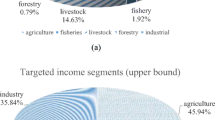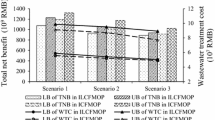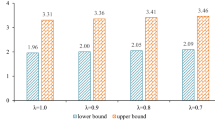Abstract
In this study, interval mathematical programming (IMP), m λ -measure, and fuzzy chance-constrained programming are incorporated into a general optimization framework, leading to a generalized interval fuzzy chance-constrained programming (GIFCP) method. GIFCP can be used to address not only interval uncertainties in the objective function, variables and left-hand side parameters but also fuzzy uncertainties on the right-hand side. Also, it can reflect the aspiration preference of optimistic and pessimistic decision makers due to the integration of m λ -measure. The developed method is applied to the long-term planning of a domestic wastewater management system in the city of Kunming, China, with consideration of the eco-environmental protection of downstream water body. The solution results of the GIFCP method can generate a series of optimal wastewater allocation patterns and WTPs capacity expansion schemes under different risk levels, provide in-depth insights into the effects of uncertainties, and consider the proper balance between system cost and risk of constraint violation.






Similar content being viewed by others
References
Azadegan A, Porobic L, Ghazinoory S, Samouei P, Saman Kheirkhah A (2011) Fuzzy logic in manufacturing: a review of literature and a specialized application. Int J Prod Econ 132:258–270
Butler D, Schütze M (2005) Integrating simulation models with a view to optimal control of urban wastewater systems. Environ Model Softw 20:415–426
Cabanillas J et al (2012) Fuzzy logic based risk assessment of effluents from waste-water treatment plants. Sci Total Environ 439:202–210
Cai YP, Huang GH, Wang X, Li GC, Tan Q (2011) An inexact programming approach for supporting ecologically sustainable water supply with the consideration of uncertain water demand by ecosystems. Stoch Env Res Risk A 25:721–735
Chang NB, Hernandez EA (2008) Optimal expansion strategy for a sewer system under uncertainty. Environ Model Assess 13:93–113
Chen YT, Chen CC (2014) The optimal reuse of reclaimed water: a mathematical model analysis. Water Resour Manag 28:2035–2048
Chen Z, Han S, Zhou FY, Wang K (2013) A CFD modeling approach for municipal sewer system design optimization to minimize emissions into receiving water body. Water Resour Manag 27:2053–2069
Flores-Alsina X, Rodríguez-Roda I, Sin G, Gernaey KV (2008) Multi-criteria evaluation of wastewater treatment plant control strategies under uncertainty. Water Res 42:4485–4497
Gao W, Howarth R, Hong B, Swaney D, Guo H (2014) Estimating net anthropogenic nitrogen inputs (NANI) in the Lake Dianchi Basin of China. Biogeosci Discuss 11:4123–4150
He L, Huang GH, Lu HW (2008) A simulation-based fuzzy chance-constrained programming model for optimal groundwater remediation under uncertainty. Adv Water Resour 31:1622–1635
Herrera-Viedma E, López-Herrera A (2010) A review on information accessing systems based on fuzzy linguistic modelling. Int J Comput Intell Syst 3:420–437
Huang GH (1998) A hybrid inexact-stochastic water management model. Eur J Oper Res 107:137–158
Huang XX (2006) Credibility-based chance-constrained integer programming models for capital budgeting with fuzzy parameters. Inform Sci 176:2698–2712
Huang GH, Sae-Lim N, Liu L, Chen Z (2001) An interval-parameter fuzzy-stochastic programming approach for municipal solid waste management and planning. Environ Model Assess 6:271–283
Iwamura K, Liu B (1998) Chance constrained integer programming models for capital budgeting in fuzzy environments. J Oper Res Soc:854–860
Izquierdo J, Montalvo I, Pérez R, Fuertes VS (2008) Design optimization of wastewater collection networks by PSO. Comput Math Appl 56:777–784
Kang D, Lansey K (2012) Scenario-based robust optimization of regional water and wastewater infrastructure. J Water Resour Plan Manag 139:325–338
Karuppiah R, Grossmann IE (2006) Global optimization for the synthesis of integrated water systems in chemical processes. Comput Chem Eng 30:650–673
Korteling B, Dessai S, Kapelan Z (2013) Using information-gap decision theory for water resources planning under severe uncertainty. Water Resour Manag 27:1149–1172
Liu B (2006) A survey of credibility theory. Fuzzy Optim Decis Making 5:387–408
Liu Y et al (2014) Quantitative evaluation of lake eutrophication responses under alternative water diversion scenarios: a water quality modeling based statistical analysis approach. Sci Total Environ 468:219–227
Maeda S, Kawachi T, Unami K, Takeuchi J, Ichion E (2010) Controlling wasteloads from point and nonpoint sources to river system by GIS-aided Epsilon Robust Optimization model. J Hydro Environ Res 4:27–36
Park D, Lee DS, Lim SR (2013) Eco-design of a wastewater treatment system based on process integration. Ind Eng Chem Res 52:2379–2388
Rojek I (2014) Models for better environmental intelligent management within water supply systems. Water Resour Manag 28:3875–3890
Seifollahi-Aghmiuni S, Haddad OB, Marino MA (2013) Water distribution network risk analysis under simultaneous consumption and roughness uncertainties. Water Resour Manag 27:2595–2610
Shibu A, Reddy MJ (2014) Optimal design of water distribution networks considering fuzzy randomness of demands using cross entropy optimization. Water Resour Manag 28:4075–4094
Sin G, Gernaey KV, Neumann MB, van Loosdrecht M, Gujer W (2011) Global sensitivity analysis in wastewater treatment plant model applications: prioritizing sources of uncertainty. Water Res 45:639–651
Sousa J, Ribeiro A, da Conceicao CM, Antunes A (2002) An optimization approach to wastewater systems planning at regional level. J Hydroinf 4:115–123
Tan Q, Huang GH, Cai YP (2013) Multi-source multi-sector sustainable water supply under multiple uncertainties: an inexact fuzzy-stochastic quadratic programming approach. Water Resour Manag 27:451–473
Tanaka T et al (2013) Irrigation system and land use effect on surface water quality in river, at lake Dianchi, Yunnan, China. J Environ Sci 25:1107–1116
Tjandraatmadja G, Sharma A, Grant T, Pamminger F (2013) A decision support methodology for integrated urban water management in remote settlements. Water Resour Manag 27:433–449
Trinh LT, Vu GNH, Van Der Steen P, Lens PN (2013) Climate change adaptation indicators to assess wastewater management and reuse options in the Mekong Delta, Vietnam. Water Resour Manag 27:1175–1191
Yang L, Iwamura K (2008) Fuzzy chance-constrained programming with linear combination of possibility measure and necessity measure. Appl Math Sci 2:2271–2288
Yang Z, Cui B, Liu J (2005) Estimation methods of eco-environmental water requirements: case study. Sci China Ser D Earth Sci 48:1280–1292
Zadeh LA (1978) Fuzzy sets as a basis for a theory of possibility. Fuzzy Set Syst 1:3–28
Zhang Y, Huang G (2010) Fuzzy robust credibility-constrained programming for environmental management and planning. J Air Waste Manage Assoc 60:711–721
Zhang YM, Huang GH (2011) Optimal water resource planning under fixed budget by interval-parameter credibility constrained programming. Eng Optim 43:879–889
Zhang L, Li CY (2014) An inexact two-stage water resources allocation model for sustainable development and management under uncertainty. Water Resour Manag 28:3161–3178
Zhang YM, Huang GH, Lin Q, Lu H (2012) Integer fuzzy credibility constrained programming for power system management. Energy 38:398–405
Acknowledgments
This paper was supported by the Major Science and Technology Program for Water Pollution Control and Treatment of China (2013ZX07102-006). Also, the authors are grateful to the editors and the anonymous reviewers for their insightful comments and suggestions.
Author information
Authors and Affiliations
Corresponding author
Electronic supplementary material
Below is the link to the electronic supplementary material.
ESM 1
(PDF 51 kb)
Rights and permissions
About this article
Cite this article
Dai, C., Cai, Y.P., Liu, Y. et al. A Generalized Interval Fuzzy Chance-Constrained Programming Method for Domestic Wastewater Management Under Uncertainty – A Case Study of Kunming, China. Water Resour Manage 29, 3015–3036 (2015). https://doi.org/10.1007/s11269-014-0902-x
Received:
Accepted:
Published:
Issue Date:
DOI: https://doi.org/10.1007/s11269-014-0902-x




